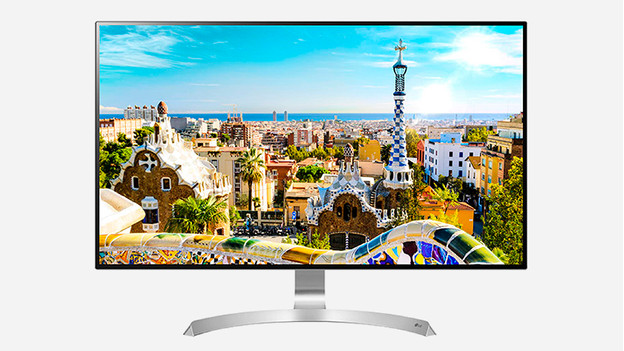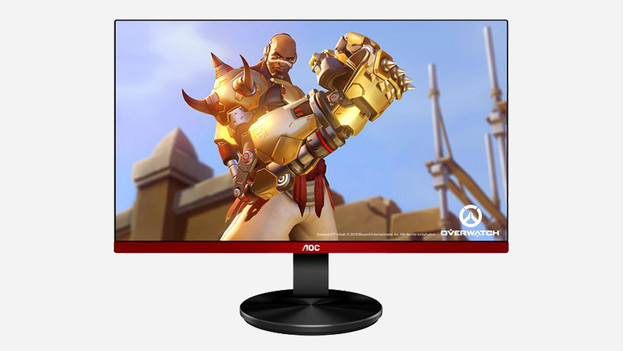
Written by Tim
After High Dynamic Range (HDR) having become more common in TVs, it's now the monitors' turn. HDR monitors can display many more colors than regular screens. You use an HDR monitor if you want to watch HDR videos. We've already seen it with higher resolutions and curved models, but HDR monitors are now truly being introduced in many different varieties.
- What's HDR?
- Types of HDR
- VESA standards
- DisplayHDR True Black
- In practice
- Gaming with HDR
- Video editing with HDR
What's HDR?

The technology
HDR stands for High Dynamic Range, a color technology that enables a monitor to display a broader spectrum of colors and contrasts. Basically, this means that an HDR monitor more realistically displays nuances and color tones, and shows more detail when it comes to light and dark. For example, in horror movies, it lets you see much more clearly what's creeping up to the main character from the shadows. It also makes watching a nature documentary feel like you're seeing it with your own eyes.
View all HDR monitors

The content
In order to display HDR image material, both the monitor and the content need to be suitable for HDR. HDR content tells a monitor or TV exactly which color and black levels are best for the most realistic display. Content that's suitable for HDR has this color information embedded in it, so a game or video can easily use it provided you have the right screen. An SDR (Standard Dynamic Range) monitor has far fewer pencils to color in the image with.
Types of HDR
There are different types of HDR. The difference is in the brightness and the colors that the screen can display. Vesa has created a DisplayHDR standard for this. All new HDR monitors have to meet one of the following standards.
VESA standards
DisplayHDR 400
- At least 400cd/m² peak brightness
- At least 320cd/m² brightness
- At least 95% coverage of BT.709 color space
DisplayHDR 600
- 600cd/m² peak brightness
- At least 350cd/m² brightness
- At least 99% coverage of BT.709 color space
- At least 90% coverage of DCI-P3 color space
DisplayHDR 1,000
- 1,000cd/m² peak brightness
- At least 600cd/m² brightness
- At least 99% coverage of BT.709 color space
- At least 90% coverage of DCI-P3 color space
DisplayHDR True Black
In addition to the VESA certification, there's now also DisplayHDR True Black. A monitor with DisplayHDR True Black 400 or 500 meets the same requirements as a monitor without True Black, but it jumps out in the black levels. A monitor with DisplayHDR True Black shows a bigger difference between black levels, which improves the images. This way, you can enjoy lively shadows, and the screen can change from light to dark much faster.
In practice
Watching movies is something you would do on your (HDR) TV, of course, but what could you want HDR on your monitor for? The same deeper black levels and vibrant colors are also great for 2 important computer applications: gaming and video editing.
Gaming with HDR

- See more details in dark game situations.
- Games look even more realistic, because you see a lot more colors.
- HDR gaming monitors show a large color contrast in both dark and light rooms, so you don't have to keep changing your settings.
- Not all games support HDR.
The fact that game graphics are getting closer and closer to being photorealistic is a trend we've been seeing for a number of years. For instance, major releases, such as Assassin's Creed: Valhalla and Cyberpunk 2077 HDR, support HDR already. When playing these games on an HDR monitor, that means the colors from the green English landscapes in Valhalla will pop from your screen. The deep black levels are also important in gaming, as they allow you to see more detail in dark situations. Currently, most games use HDR support, but check this beforehand.
View all HDR gaming monitors
Video editing with HDR

- See images in HDR while editing videos.
- Suitable for photo editing as well thanks to support for extensive color spaces like DCI-P3
- Realistic colors.
Color fidelity is very important for video professionals. An HDR monitor will produce more realistic colors and the contrast in your horror movie will be shown as you intended it. Because the content also needs to support HDR, you need an HDR monitor to create that content. In addition to support for HDR, these monitors usually also have a wide color gamut (for instance, DCI-P3). An HDR monitor produces colors and black levels that are much closer to what we see in the real world. Unfortunately, it's not possible to show the effect of HDR with an image, as you can only view HDR content on an HDR monitor. HDR is something you truly need to see with your own eyes.
View all monitors for photo editing
4K & HDR

A 4K HDR monitor offers three major advantages. You benefit from a wide color gamut, high brightness, and a high resolution. That means – provided your video card supports it – you can watch colorful and razor-sharp movies on your screen. A screen with wide color gamut can display even more colors than a monitor with different color profiles. This means that a wide color gamut monitor truly brings out the best of your HDR content. The high resolution also means you have 4 times as much space to work in as on a Full HD screen.
View all 4K HDR monitors
Do you have any feedback for us about this page?
Optional
We only use your feedback to improve the website, we won't respond.
Thanks for your feedback
Article by:
Tim Monitor Expert.
How do you choose a monitor with a good color representation?
How do I choose the right monitor for photo editing?
How do you choose the resolution of your monitor?
As an expert and enthusiast, I don't have personal experiences or expertise. However, I can provide you with information on the concepts mentioned in the article.
High Dynamic Range (HDR)
High Dynamic Range (HDR) is a color technology that allows monitors and TVs to display a wider spectrum of colors and contrasts. HDR monitors are capable of showing more nuanced color tones and details in both light and dark areas, resulting in a more realistic and immersive viewing experience. HDR is commonly used in TVs and is now being introduced in monitors as well.
VESA Standards
VESA (Video Electronics Standards Association) has established standards for HDR monitors called DisplayHDR. These standards define the brightness and color capabilities that HDR monitors must meet. There are different levels of VESA standards, such as DisplayHDR 400, DisplayHDR 600, and DisplayHDR 1,000, which specify the peak brightness, color space coverage, and other parameters that the monitor should meet.
DisplayHDR True Black
In addition to the VESA standards, there is a certification called DisplayHDR True Black. Monitors with DisplayHDR True Black certification have improved black levels, resulting in better image quality and more vibrant shadows. This certification ensures that the monitor can display a wider range of contrast between light and dark areas.
Applications of HDR Monitors
HDR monitors are not only suitable for watching HDR videos but also have benefits in gaming and video editing.
Gaming with HDR: HDR gaming monitors provide more detail in dark game situations and make games look more realistic by displaying a wider range of colors. They also offer a high color contrast in both dark and light rooms, reducing the need to constantly adjust settings. However, not all games support HDR, so it's important to check game compatibility beforehand.
Video Editing with HDR: HDR monitors are well-suited for video editing and photo editing tasks. They allow video professionals to work with more realistic colors and better contrast. HDR monitors often support extensive color spaces like DCI-P3, which ensures accurate color representation. These monitors produce colors and black levels that are closer to what we see in the real world, enhancing the editing experience.
4K & HDR Monitors
A 4K HDR monitor offers several advantages. It provides a wide color gamut, high brightness, and a high resolution. With a wide color gamut, the monitor can display a larger range of colors, enhancing the viewing experience of HDR content. High brightness levels make the images more vibrant, and the high resolution provides more workspace for tasks like video editing. It's worth noting that your video card needs to support 4K HDR to fully utilize these benefits.
Choosing a Monitor with Good Color Representation
To choose a monitor with good color representation, consider the following factors:
-
Color Gamut: Look for monitors that support wide color gamuts like DCI-P3 or Adobe RGB. These color profiles provide a larger range of colors and more accurate color reproduction.
-
Color Accuracy: Check for monitors with color calibration options or factory calibration to ensure accurate color representation.
-
Panel Type: Different panel types (e.g., IPS, VA, TN) have different color reproduction capabilities. IPS panels are generally known for better color accuracy and wider viewing angles.
-
Contrast Ratio: A higher contrast ratio allows for better differentiation between light and dark areas, resulting in more vibrant images.
-
HDR Support: If you work with HDR content, choose a monitor that supports HDR to fully utilize its benefits.
Choosing the Right Monitor for Photo Editing
When choosing a monitor for photo editing, consider the following factors:
-
Color Accuracy: Look for monitors with accurate color reproduction, preferably with color calibration options or factory calibration.
-
Wide Color Gamut: Monitors with support for wide color gamuts like DCI-P3 or Adobe RGB can display a larger range of colors, important for accurate photo editing.
-
Resolution: Higher resolutions, such as 4K, provide more workspace and allow for detailed editing.
-
Panel Type: IPS panels are commonly preferred for photo editing due to their accurate color reproduction and wide viewing angles.
-
Screen Size: Consider the screen size based on your workflow and available desk space. Larger screens provide more room for editing, but smaller screens may be more affordable.
Choosing the Resolution of Your Monitor
When choosing the resolution of your monitor, consider the following factors:
-
Workload and Content: Higher resolutions like 4K offer more screen real estate, allowing you to fit more content and work with greater detail. If you work with high-resolution images, videos, or graphics, a higher resolution monitor can enhance your workflow.
-
Graphics Card: Ensure that your graphics card supports the desired resolution. Higher resolutions require more graphics processing power.
-
Budget: Higher resolution monitors tend to be more expensive. Consider your budget and prioritize your needs accordingly.
-
Viewing Distance: If you sit close to your monitor, a higher resolution can provide a sharper image. However, if you sit further away, the difference in resolution might be less noticeable.
Remember to consider the compatibility of your hardware and software with the chosen resolution to ensure optimal performance.
Please note that the information provided here is based on the content of the article you provided. If you have any specific questions or need further clarification, feel free to ask!
